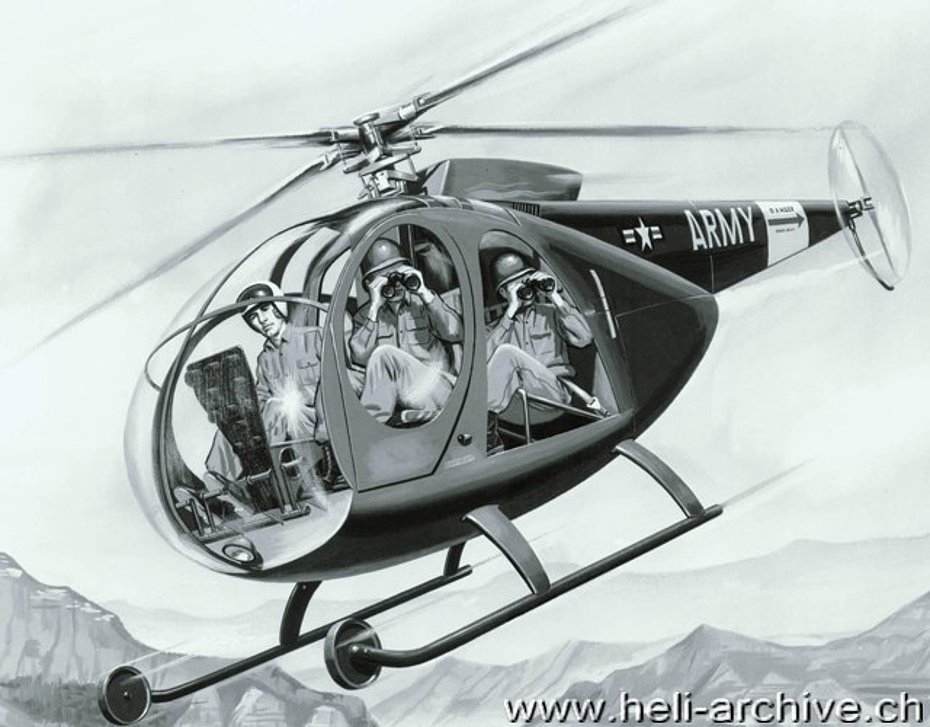
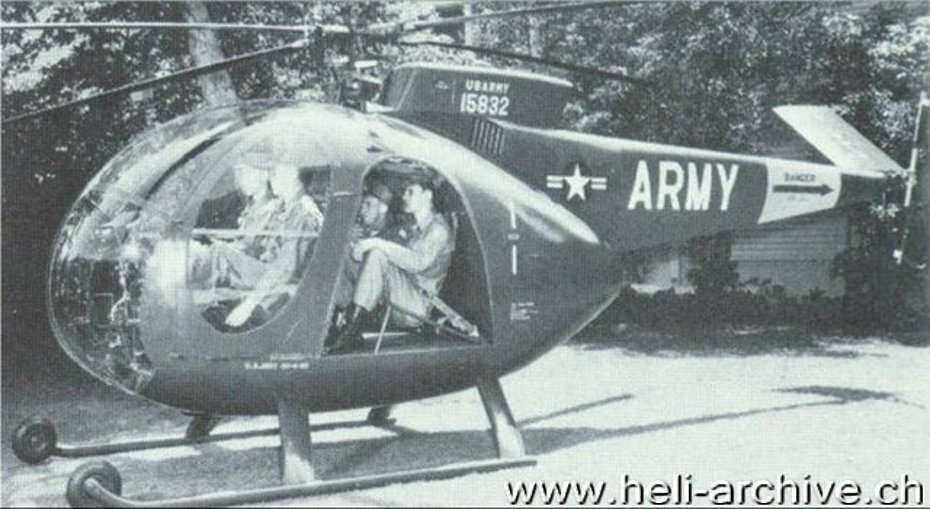
Hughes 369HS/500C - History and technical description
Some historical notes
The origins of this helicopter, also known under the commercial designation of Hughes 500, dates back to the early 1960s. In those years a work group known as Army Aircraft Requirements Review Board, or simpler Rogers Board from the name of its president who chaired the group of generals Gordon Byrom Rogers, issued some request for proposals for new aircraft. Among these there was the need for a new light helicopter.
During the 1950s the US Army successfully tested the rotary-wing potentials and discovered its great versatility.
However it was necessary to modernize the fleet in view of the creation of the "air cavalry", which then became the icon of the Vietnam war.
Specifically the US Army needed a light single-rotor, four place aircraft capable of carrying in addition to the pilot, a fuel reserve for three hours and a payload of 180 kg (400 pounds) at a cruise speed of at least 204 km/h (110 knots).
Furthermore it had to be manufactured at low cost, be easily maintainable, reliable, with specified performance, minimum time between overhaul of at least 1'200 hours and certified by the Federal Aviation Agency (FAA).
The request for proposals also imposed that the engine to be used had to be the new turboshaft Allison T-63 (commonly known under the civil designation Allison series 250), which at that time was produced by the Allison Division of General Motors Corporation.
The US Army in fact intended to replace the light helicopters of the Bell OH-13 and Hiller OH-23 series, as well as the Cessna O-1 Bird Dog frequently used as "jeeps of the air".
In early 1961, seventeen proposals from twelve manufacturers (Bell, Boeing, Cessna, Gyrodyne, Hiller, Hughes, Kaiser, Kaman, Lockheed, Mc Donnell, Republic, Sikorsky) were submitted.
At the beginning only two proposals were selected: that of the Bell with the project of the Model 250, and that of the Hiller with the project of the Model 1100.
The readmission of the Hughes Tool Company
For reference only, it must be said that the Army's LOH contest (LOH acronym for Light Observation Helicopter) was characterized by some striking surprises worthy of a spy story.
The first surprise was the readmission of the Hughes Tool Company whose president was the famous billionaire Howard Hughes. Bell and Hiller learnt the news with understandable disappointment: great interests, not only of financial character, were at stake. The US Army in fact estimated a global need of about 3'600-4'000 LOH helicopters.
Hughes readmission was apparently justified by the fact that the team of engineers lead by Malcolm Stuard Harned (1921-1980) announced top performances, better than those fixed by the US Army, still judged by insiders as very strict.
The team of Culver City explained that their helicopter would incorporate a number of technical innovations which not only made it lighter but also cheaper.
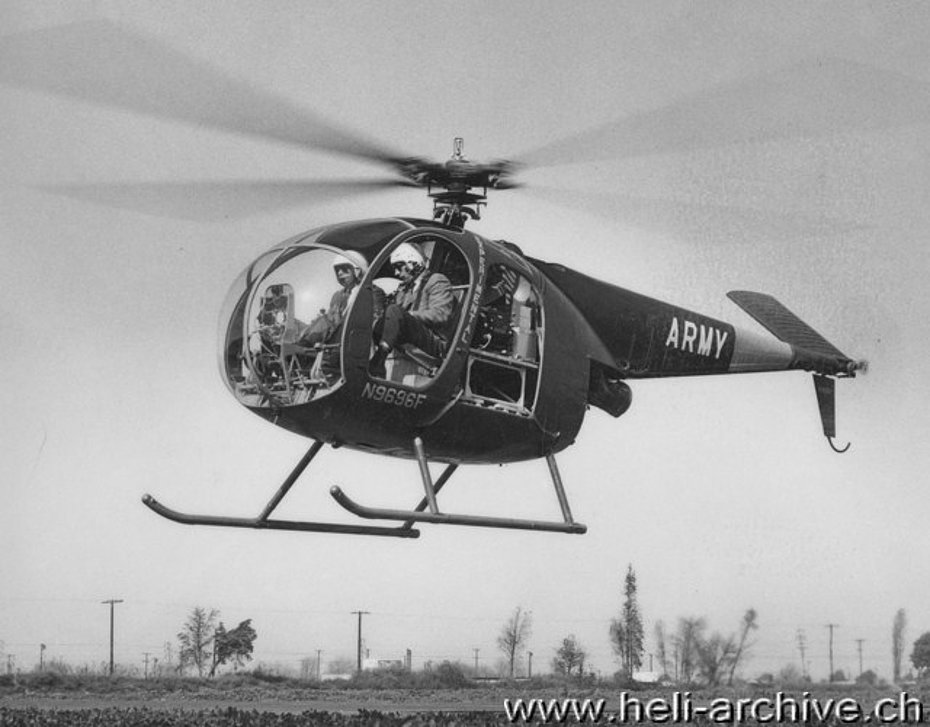
The team of Culver City explained that their helicopter would incorporate a number of technical innovations which not only made it lighter but also cheaper.
On May 19, 1961 the Hughes Tool Company signed the US Army contract for the development and the construction of five prototypes. The first of them registered N9696F (initially designated YHO-6 and then, when a new classification system was introduced, OH-6A) made its first flight in Culver City on February 27, 1963 piloted by Raleigh Fletcher and James "Jim" Albert Vittitoe.
Compared to the model produced in series the prototypes presented several differences.
Sixth-scale wind tunnel tests revealed a parasitic fuselage drag. For this reason the fuselage was "cleaned" and some modifications were introduced. The rotor hub, mask and swashplate drag for example were reduced by a new fairing. The original flush engine air intake was replaced with a new one placed in front of the mast fairing.
The original blade cuffs, also designed to reduce drag, were abandoned from the production models. The original tailboom was modified and made thinner. Always to reduce drag the landing gear legs were covered with aerodynamic fairings.
Initial test flights showed that although the aerofoil on the tail boom worked well in cruise flight it prevented sidewards flight faster than 5 knots. A symmetrical boom was substituted and with this modification the helicopter was able to fly sideways at over 60 knots. The tailplane also gave some troubles and several types were tested before a satisfactory one was found. First flights also showed that the rotor system was unstable and had unsatisfactory vibration from the four main rotor blades.
After some initial problems with the turboshaft tweak the five prototypes underwent a severe six months test program prepared by the US Army at Fort Rucker, Fort Benning, Fort Ord and Edward Air Force base. Extreme cold weather test were conducted at Eglin Air Force base at temperatures down to -50°C.
The competition from a technical point of view
As predictable, the confrontation between the finalists highlighted virtues and vices of each model. Most of Hughes' promises were however confirmed by the facts.
Compact, light (its max. take-off weight was 20%, and the empty weight 30% less than its competitors) and very aerodynamic the OH-6 displayed excellent performances. Its cruising speed for example was 228 km/h against 185 km/h of the Bell OH-4A and 205 km/h of the Hiller OH-5A.
Its extreme lightness was obtained thanks to its compact dimensions and a series of innovative technical solutions as for example a simplified transmission, the elimination of the heat exchanger used to cool the transmission, the one-piece tail rotor drive shaft with no coupling or bearings and last but not least a new rotor type called Flexrotor.
To mention also that the OH-6A could lift a payload equal to 110% of its empty weight.
As established by the US Army contract the helicopter obtained the civil certification (type certificate H3WE) issued by the Federal Aviation Agency on June 30, 1964. The new helicopter received FAA designation Hughes Model 369, while later it was marketed as the Model 500.
The war of the prices
In Autum 1964 when the military evaluation program was concluded two LOH were judged suitable to fulfill the US Army needs. The models concerned were the Hughes OH-6A and the Hiller OH-5A.
Since both aircraft had won, the final competition was essentially based on cost.
From November 1964 until May 1965 the two manufacturers had time to prepare their offers for the delivery of a first batch of 714 units.
Hiller which fusioned during 1964 with Fairchild becoming Fairchild-Hiller established for its OH-5A a price of 29'415 USD while Hughes, for the first 714 OH-6A tendered a price of only 19'860 USD per aircraft. Rumours said that the rich and wily Hughes through industrial espionage was able to find out how much Fairchild Hiller was going to bid for their ships.
With his bid Hughes knew he'd lose money on the initial order, but would surely make it up on the additional ships if the contract did indeed run out to 3'600-4'000 LOH.
When the news concerning Hughes' bid was released new critics were adressed to the US Army and to Howard Hughes who was accused of unfair competition.
Edward G. Uhl Fairchild-Hiller's president in an interview for the Wall Street Journal told that Hiller could not even buy materials for the price tendered by Hughes.
For reference the US Army in the first stages of the competion estimed the price for the LOH in the 32'000-34'000 USD range, while in the same period Hughes sold its Hughes 269A at a price of 22'500 USD.
On May 26, 1965 Hughes signed the contract for the production of a first batch of 714 OH-6A.
From March 1967 many OH-6A were sent to Vietnam where they were employed with success, even if initially there were some serious accidents due to uniball separation in the rotor head. The uniball made of Teflon started flaking apart. If this happened in flight the consequences were catastrophic.
As we know Howard Hughes paid a high price the consequences of his politics. In fact in 1967 the US Army reopened the competition. Bell and Hughes were invited to bid again while Fairchild-Hiller decided not to resubmit their bid with the OH-5A, instead choosing to continue with commercial marketing of their civilian version, the FH-1100.
It seems that Hughes ignoring the advice of his confidential counsellor Jack Real added of his own initiative 3'000 USD to the bid price calculated by the technicians.
This time Bell won the competition with its new OH-58 (the military version of the Jet Ranger) offered for a price of 54'200 USD while Hughes bid a price of 56'550 USD for his OH-6A!
Someone estimed that with the LOH competition Hughes lost about 90 USD millions.
Despite the bitter defeat Hughes succeeded and eventually sold numerous helicopters for military and civil uses.
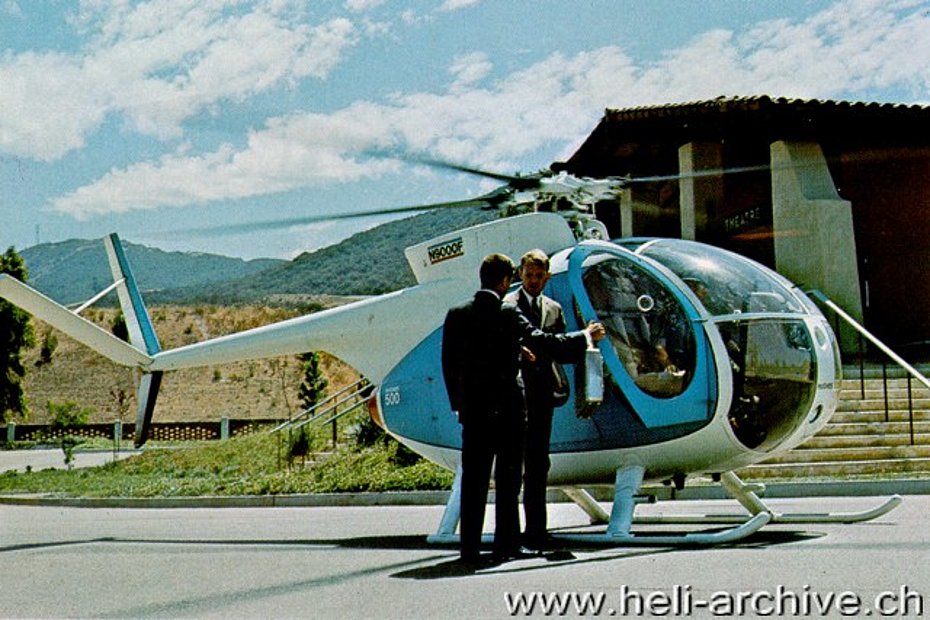
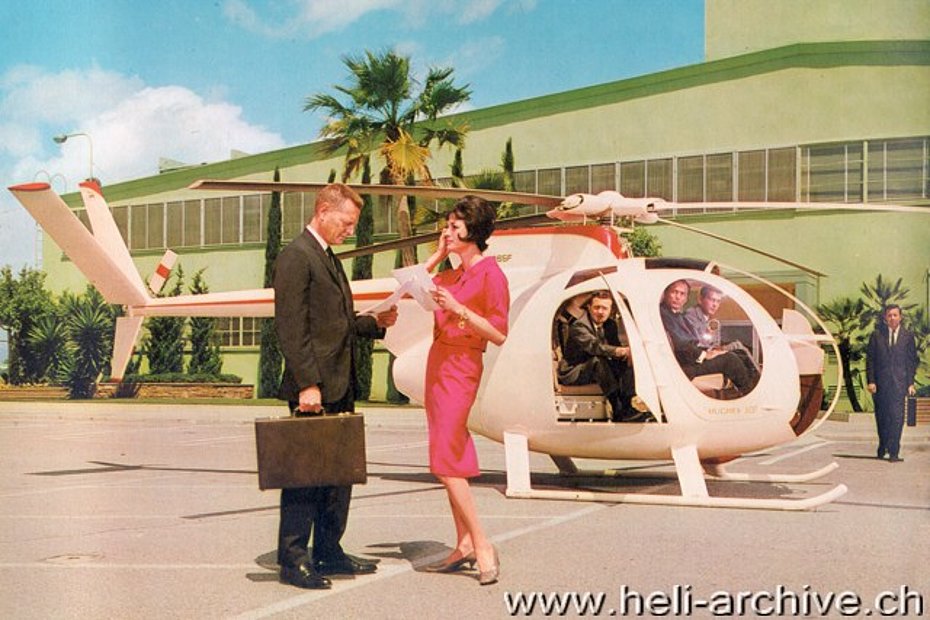
The civil production
As far back as 1966 Hughes announced its intention to manufacture commercial variants of the OH-6A. Two versions were initially advertised, these being the 500U (Utility) and the 500 Executive. The first was offered at a sale price of 75'800 USD while the price of the second was 78'800 USD.
The first commercial helicopter was N9000F, which was apparently nothing else than an OH-6A.
N9000F made one of its first official apparition between the 15-18, 1967 in Palm Springs (California) during the annual meeting ot the Helicopter Association of America.
In May of that year the helicopter toured Europe piloted by Harold (Hal) W. Hawkins.
However almost two years elapsed until the first "true" commercial version, which could accommodate four passengers, obtained its FAA type certificate.
The first models manufactured in Culver City for the civil market from May 1969 were the Hughes 369HS, which obtained type certificate on January 3, 1969, and the 369HE certificated on May 21, 1969.
Except for interior trim upholstery and floor coverings, equipment furnishings, paint finish and other details, the 369HS and 369HE are essentially identical to the basic helicopter configuration. Normally, the 369HS has the standard trim package and the 369HE has the executive trim package. The interiors of the new models were designed by the well-known American stylist Henry Dreyfuss.
Furnishing variations between models included a passenger/cargo compartment folding table, passenger steps, and different ashtray locations and passenger/cargo convenience panels.
In the United States the production of the mentioned versions ceased in 1976 when the new version 369D/500D was introduced.
The Hughes 369HS has been produced under license in Italy (Breda-Nardi Costruzioni Aeronautiche SpA), in Japan (Kawasaki Heavy Industries Ltd.), South Korea (Korean Air Lines Co.) and Argentina (Representaciones Aero Comerciales Argentinas SA - RACA).
Civil employ
Though born as a military helicopter the Hughes 369/500 has found a wide range of applications among the civil operators. Its multi-role character makes it suited for almost every kind of light transportation. Despite the long period elapsed from its first flight it is still used worldwide and appreciated for its versatility, even though probably commercial operators prefer to use the latest versions of this series.

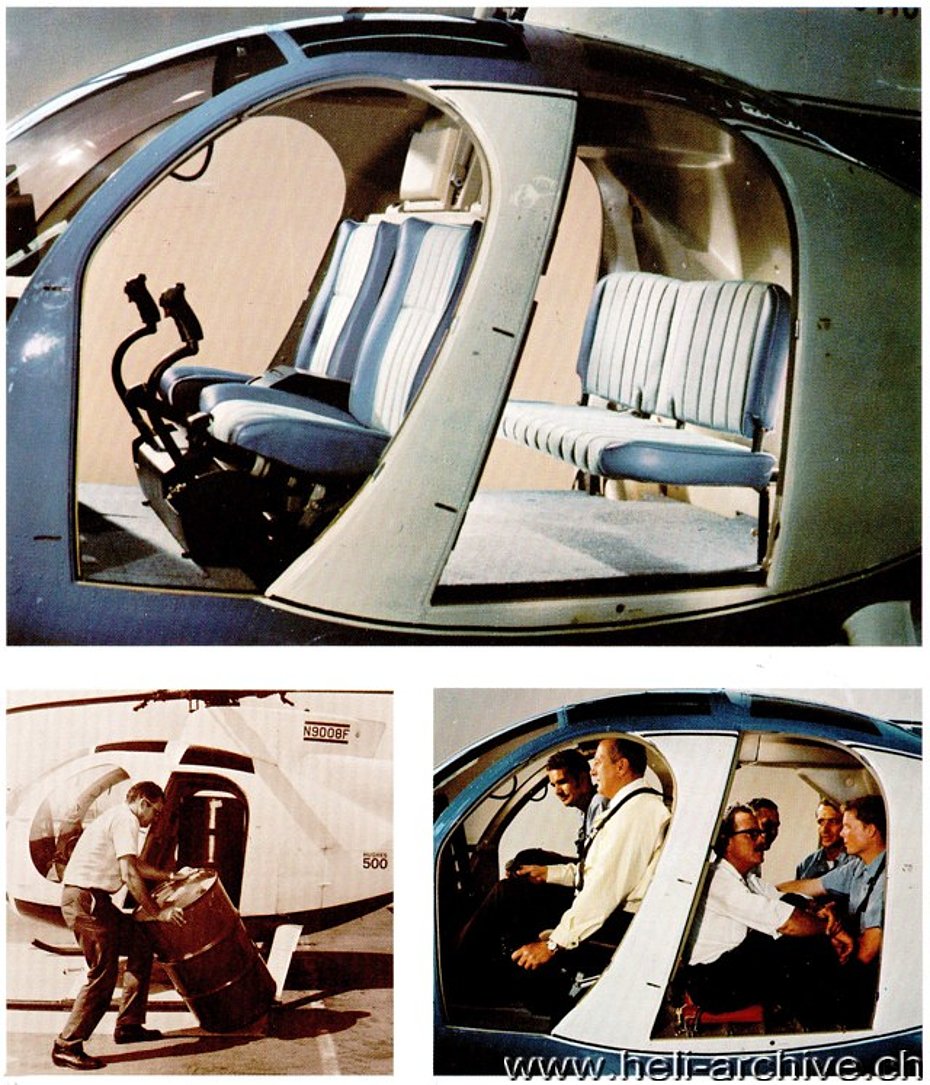
General technical description
Unless otherwise stated, information presented in this general technical description pertains to both Model 369HS or 369HE helicopters equipped with the Allison 250−C18 or 250−C20 engines.
The Hughes 369HS is a light five seat multi-purpose helicopter of standard configuration. It has a four blade fully articulated main rotor, while the tail rotor is a two-bladed semi-rigid type.
Its distinctive airframe structure is egg-shaped and provides very clean aerodynamic lines. The rigid, three-dimensional truss type structure increases crew safety by means of its roll bar design. The airframe structure is designed to be energy absorbing and fails progressively in the event of impact.
The fuselage is a semi-monocoque structure that is divided into three main sections: forward section, cargo/passenger center section, aft or engine section.
The forward section is comprised of a pilot compartment with seats for the pilot and either one or two passengers.
A canopy of transparent tinted acrylic panels provides excellent visibility for the pilot. The left seat in the pilot's compartment (looking forward) is the pilot's seat (command position). In special military versions the pilot's seat is on the right side and the center seat is eliminated. The passengers sit to the right, abreast of the pilot. With three occupants the front space in the cabin is quite limited. An instrument panel is located forward of the seat at the aircraft centerline. The panel incorporates standard flight and engine instruments in addition to warning and caution lights. The panel also contains adequate space provisions for various arrangements of communication and navigation equipment.
The lower fuselage structure beneath the pilot/passenger floor contains compartment space for the aircraft battery and provision for small cargo storage or installation of avionics equipment. Access to the compartments is through two floor door plates.
Four doors are installed on the helicopter, two on each side. The two forward doors permit access to the forward compartment for pilot and passengers.
The cargo compartment (center section) has a volume of 1.18 cubic meter and contains provisions for installation of a bench or individual folding type passenger seats, which are adjustable in height.
Seat belts are provided with several styles being offered. The seats and belts are easily removed. Cargo compartment bench-type seats may be easily folded out of the way or completely removed for accommodating cargo.
During cargo carrying operations, the compartment floor serves as the cargo deck. Removable and interchangeable cargo tiedown fittings are available. Observing the floor charge limits the max cargo capacity is 590 kg.
To highlight available internal volume advertising photographs often show two standard 208 litres (55 gallons) fuel drum in this compartment.
The two aft doors with tinted windows allow entry to the passenger/cargo compartment.
The lower section is divided by the center beam and provides a housing for the two fuel cells which have a total capacity of 242 litres. Provisions for the attachment of a cargo hook are located on the bottom of the fuselage in line with the centre beam.
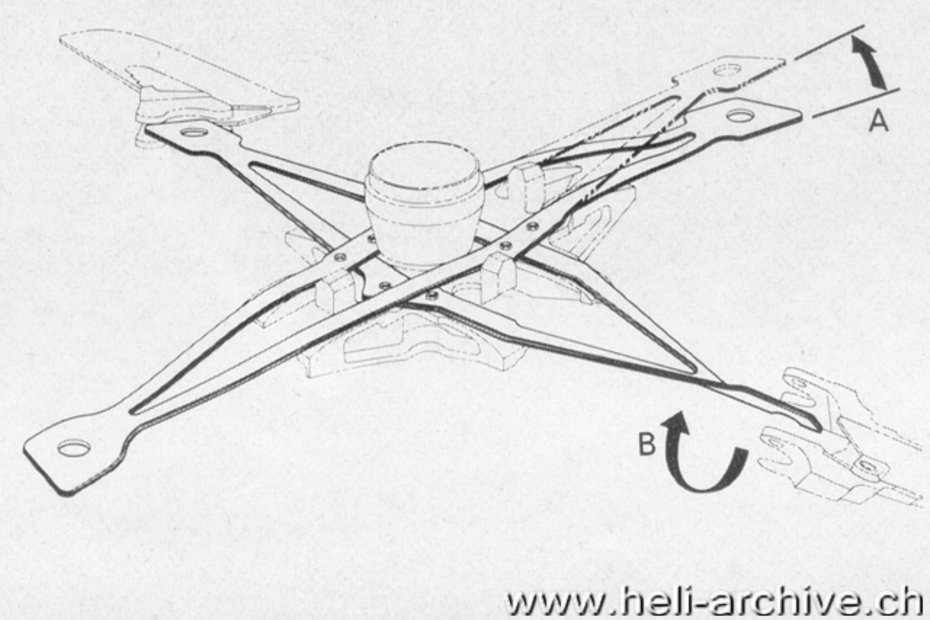
The aft section includes the structure for the tailboom attachment and engine compartment.
The tailboom is a monocoque structure of aluminum alloy frames and skin. The tailboom is the supporting attachment structure for the stabilizers, tail rotor transmission and tail rotor. The tailboom also houses the one piece dynamically balanced shaft which requires no intermediate couplings or bearings. Access to the engine compartment is provided through clamshell doors contoured to the shape the fuselage.
Power from the turboshaft engine is transmitted through the drive shafts to the main and tail rotor transmissions. An overrunning (one-way) clutch, placed between the engine and main rotor transmission, permits free-wheeling of the rotor system during autorotation.
The landing gear is a skid-type attached to the fuselage at 12 points. Nitrogen charged landing gear dampers act as springs and shock absorbers to cushion landings and provide ground resonance stability. Aerodynamic fairings cover the struts. Provisions for ground handling wheels are incorporated on the skid tubes.
Rotor, transmission and control
The main rotor static mast is non-rotating and is rigidly mounted to the mast support structure. The rotor hub is supported by the rotor mast. Torque is transmitted independently to the rotor through the main rotor drive shaft, thus lifting loads are prevented from being imposed onto the main transmission eliminating thrust loading of transmission parts.
The helicopter utilizes a four bladed, fully articulated main rotor assembly with unique features.
The "Flexrotor" developed by Hughes' engineers uses flexible strap packs each containing fifteen high-strength stainless steel straps to support the rotor blades. These straps allow the blades to flap or to vary in pitch angle as illustrated.
The truss shape in the horizontal plane transmits the shaft torque to the blades causing the blades to rotate.
By this arrangement lubricated bearings have been eliminated. With the flexible root attachment centrifugal force holds the blades in contrast to rotors with a rigid carry-trough structure at the root. The combination of the strap flexibility plus the continuous load path from one blade across to the opposite blade saved at least 45 kg of empty weight.
Cyclic, collective, and adjustable pedal controls are provided at the left crew position. Adjustable friction devices, which may be varied to suit the individual pilot, are incorporated in the cyclic, collective and throttle controls. In addition, electrical cyclic trim actuators allow flight loads to be trimmed out. Since stick control forces are low, a hydraulic boost system is unnecessary. An optional dual control system may be easily removed to provide room for passengers or cargo.
The tail rotor transmission is mounted on the aft end of the tailboom and has a self contained lubrication system. The tail rotor is mounted on the output shaft of the transmission and consists of two metallic variable pitch blades.
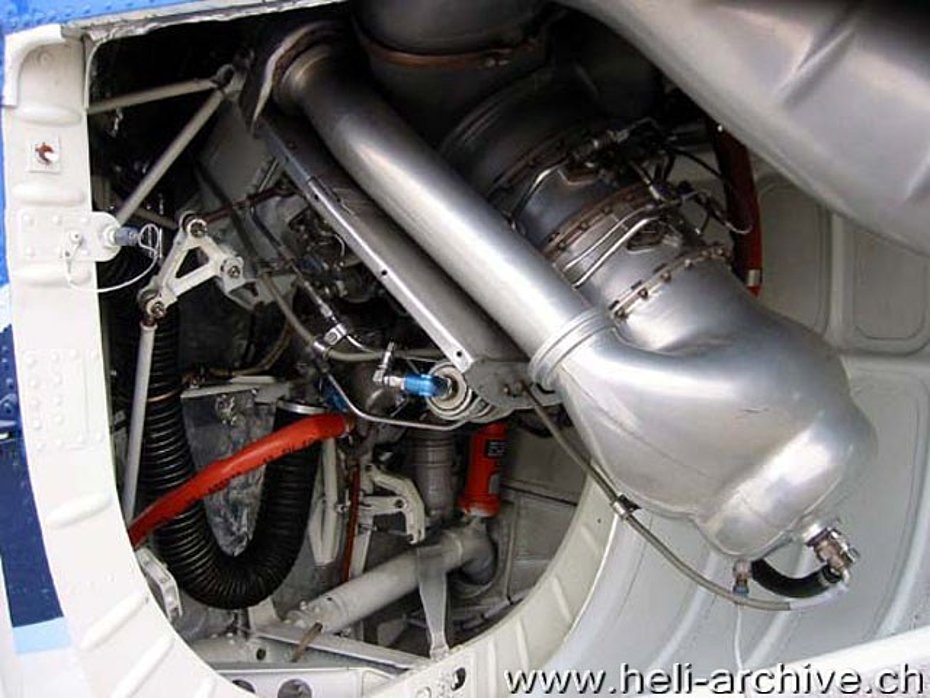
Turboshaft and transmission
On customer's choice the helicopter could be furnished either with the Allison Model 250-C18A turboshaft with a takeoff power rating of 233/317 kW/shp or the more powerful Allison 250-C20 with a take-off power rating of 294/400 kW/shp.
With the latter turboshaft installed the 369HS assumes the commercial designation of Hughes 500C.
This compact and light power plant (its weight is about 64 kg) is a derivative of the T63-A-5 originally sponsored jointly by the US Army and USAF from June 1958 onwards as the T63 for the new LOH.
The successive and more powerful version (military known as the T63-A5A) got the FAA certification in September 1965 with the designation 250-C18. Its average fuel consumption is about 80-90 litres/h.
Limited take-off power (5 min) is 207/278 kW/shp at 104 percent N2 RPM; the max. continuous power is 181/243 kW/shp.
Limiting the maximum power to less than the maximum rated power provides a higher engine critical altitude. The power turbine governor provides automatic constant speed control of rotor RPM.
The overrunning clutch transmits power from the engine to the main drive shaft. The clutch disengages automatically during autorotation and engine shutdown. The main drive shaft connects to the main rotor transmission input shaft. The engine oil cooler blower is belt driven off the main drive shaft. The oil cooler blower draws cooling air from the air inlet fairing to supply ambient air to the engine oil cooler and to the engine compartment.
The main rotor transmission is mounted on the basic airframe structure above the passenger/cargo compartment. The transmission is lubricated by its own internal lubrication system.
Performances
In ISA conditions, at 1'157 kg take-off weight, the helicopter has a cruising speed of about 232 km/h, while the never exceed speed at sea level is 241 km/h (130 knots). In the same conditions the helicopter hovers in ground effect at about 2'500 meters, or 1'615 meters out of ground effect. The initial rate of climb at sea level is about 520 m/min. Its service ceiling is 4'389 meters.
Its range is about 600 km corresponding to 3h of flight endurance.
Dimensions, weights and payload
The main rotor of the Hughes 369HS has a diameter of 8.02 m (disc rotor area 50.5 sm), while its tail rotor has a diameter of 1.29 m (rotor disc area 1.31 sm. The fuselage has a length of 7.01 m. The height measured on the top of the rotor mast is 2.50 m (with low skid landing gear). The aircraft standard empty weight is about 565 kg, while its MTOW is 1'157 kg with internal load, or 1'225 kg with external load. The helicopter can transport up to 4 passengers with their baggage. The cargo hook kit is designed to carry loads up to 816 kg. With this helicopter usually pilots transport loads of about 350-400 kg.
Optional equipment
The versatility of the Hughes 369/500 could be further extended by the availability of a wide range of accessories and kits such as: dual controls, cabin heater, seating and belts for four on the floor, military type seat, fixed cargo hook, extended landing gear, emergency float, utility floats, litter ambulance kit, hoist, luggage pod, passenger step, rotor brake, extinguisher, first aid kit.
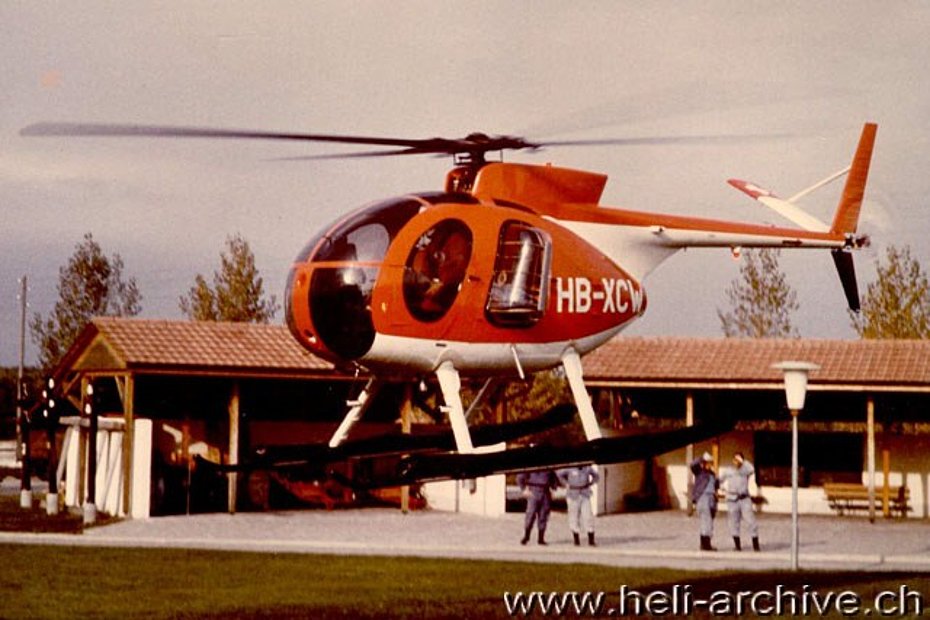
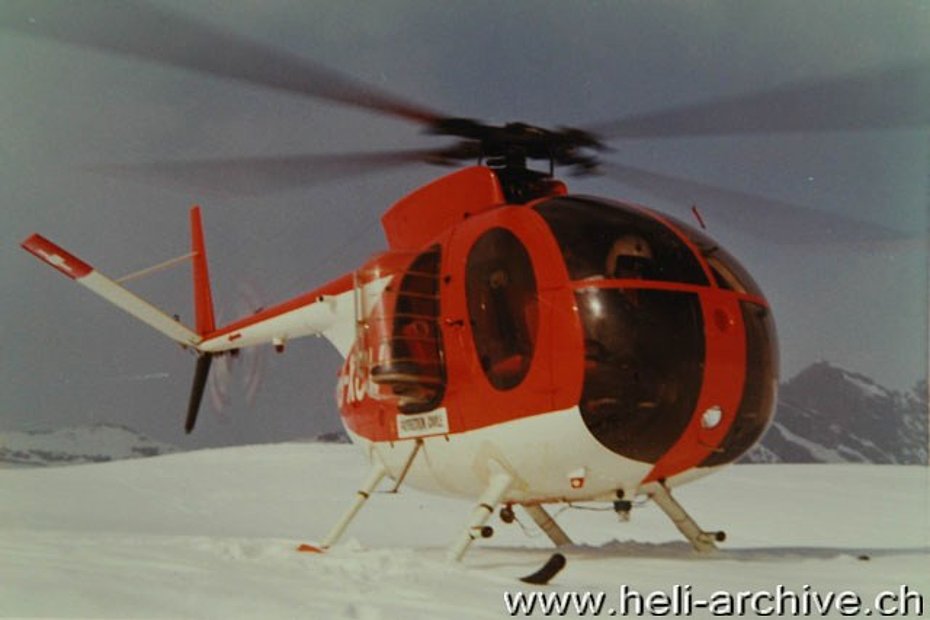
The Hughes 500 in Switzerland
Most probably the Hughes 369/500 made its first appearance in Switzerland early June 1967 when N9000F was officially presented at the airport of Geneva-Cointrin. This helicopter was used as demonstrator by Hughes Tool Company to promote civil sales. Although N9000F was registered as a civil helicopter, in reality it was merely a "civilised" OH-6A.
This helicopter which was piloted by Harold (Hal) W. Hawkins arrived from France where it attended the 27th Paris Air Show between May 26 and June 4.
During the Paris Air Show Hawkins trained Willy Meier who was at that time employed as a mechanic and pilot by the Rotorcraft company based in Geneva, the Swiss representative of Hughes Tool Company. On May 28, Meier did the transition course on the new helicopter and become almost certainly the first Swiss to obtain the qualification to pilot the Hughes 369/500.
The HB-XCW: the first Hughes 369/500 to be registered in Switzerland
From 1968 the Canton of Geneva started to use experimentally a Hughes 269B for civil defence and police tasks. The positive experience led to the decision to purchase a larger helicopter.
Due to the fact that the Hughes 369/500 was one of the quietest helicopter on the market and the Rotorcraft (which belonged to William "Bill" Lear, founder of the Lear Jet Corporation) was based in Geneva-Cointrin, the choice fell on the Hughes 369HS.
In Autumn 1970 the Geneva Council of State financed its purchase with a credit of 640'000 CHF. The purchase contract was signed on December 11, 1970.
A few months later the helicopter arrived in Switzerland and between March 29, and April 13, 1971 it was assembled by technicians of Pilatus Air Service.
The new helicopter (s/n 110275S) received the Swiss registration HB-XCW and was nicknamed "Ariane".
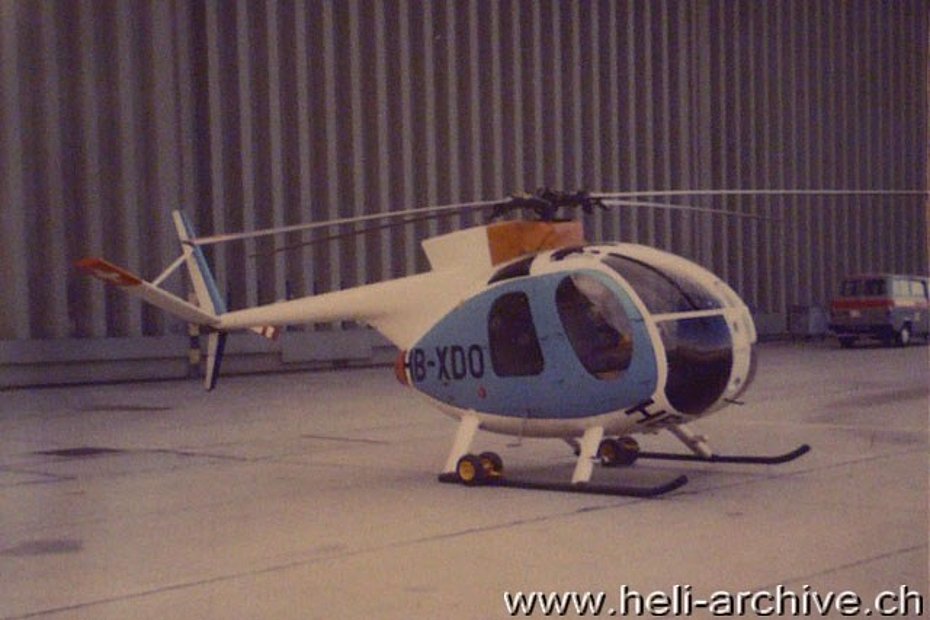
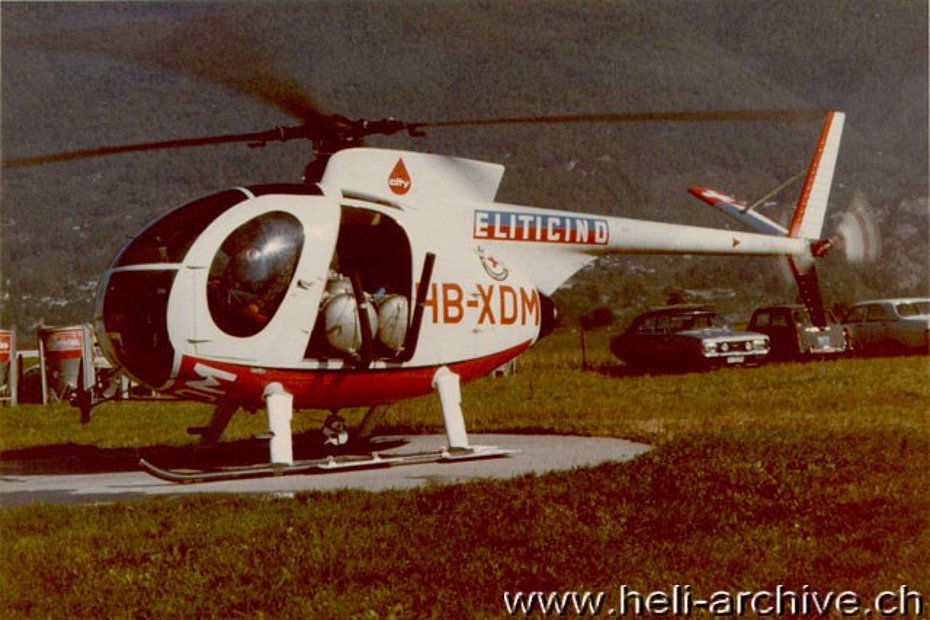
The new helicopter was inspected by the technicians of the Federal Office of Civil Aviation on May 12, 1971 and immediately thereafter started to be used by the pilots Jean Baer (chief-pilot of the Protection Civile), Georges Castella, Georges Raemy and Marcel Gaille.
When necessary the helicopter was quickly converted for medical evacuation. This was possible thanks to a special ambulance kit.
On March 2, 1972 HB-XCW was seriously damaged during a training flight in Canton Valais on the Tsanfleuron glacier at an altitude of 2'580 m.
During the landing manoeuvre the pilot lost his reference points and few instants later the helicopter rolled over on the snow covered terrain. The pilot who was alone on board was not injured but the helicopter, which had in the meantime logged about 150 hours of flight, was seriously damaged.
It was repaired during the Summer and went back into service until May 1975 when it was replaced by Bell 206B Jet Ranger II HB-XEP, which was slightly larger.
During its period of service in Switzerland HB-XCW logged altogether about 793 flight hours. In June 1975 it was sold to Transair, and a month later it was cancelled from the Swiss aircraft register.
The helicopter was sold at first in Germany as D-HFSF and then in England as G-GASB.
Commercial operations
In the course of 1971 two more Hughes 369/500 were registered in Switzerland. The first was second-hand HB-XDO purchased by Robert Fuchs (369HE s/n 59-0101E b/y 1969), and the second was HB-XDM (369HS s/n 31-0300S b/y 1971) purchased by the Depos company, but registered and operated by Eliticino.
It is confirmed that the Ticino based helicopter company expressed its interest for the Hughes 500 already in 1966, but in those years all production was intended for the US Army.
The purchase contract between the Eliticino and the Hughes Tool Company was signed on July 2, 1971.
HB-XDM was intensively used for commercial transportation of passengers and freights until the end of 1974. Then it was sold to the Belgian company Heli-West.
During its period of service in Ticino this helicopter logged altogether about 1'500 flying hours. Delta-Mike lifted an external load of about 400 kg. For commercial flights its cost was 17.- CHF/min.
Interesting news
On April 6, 1966 in 15h08' Hughes test pilot Robert G. Ferry flew a stripped-down Hughes OH-6A helicopter from Culver City to Ormond Beach (Florida) without refueling or stopping - a record distance of 3'561 km that still stands. In that occasion the helicopter lifted a payload (fuel) which was twice as heavy as its empty weight!

